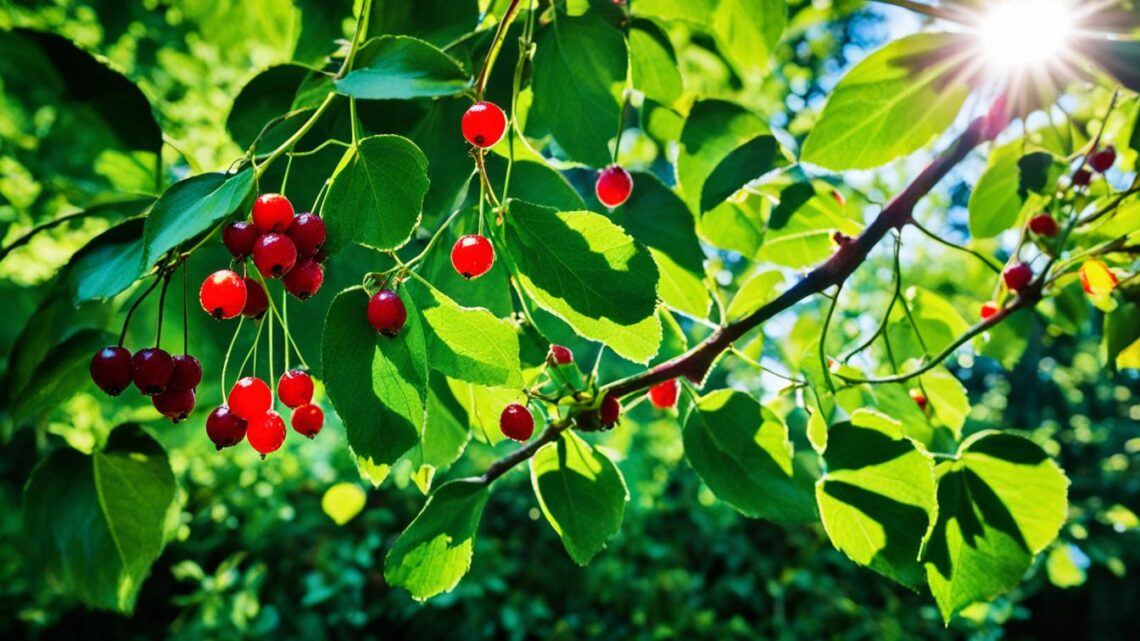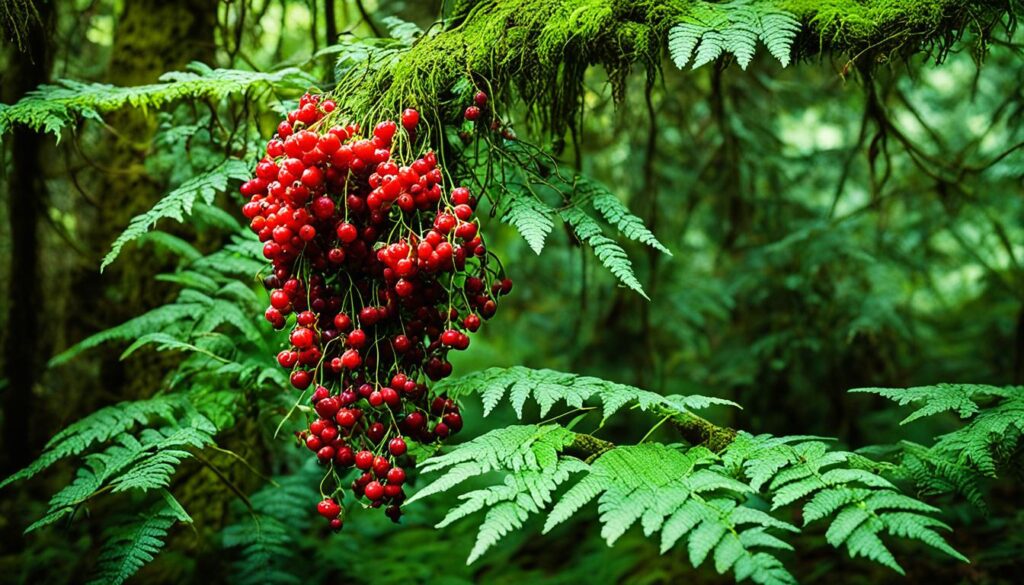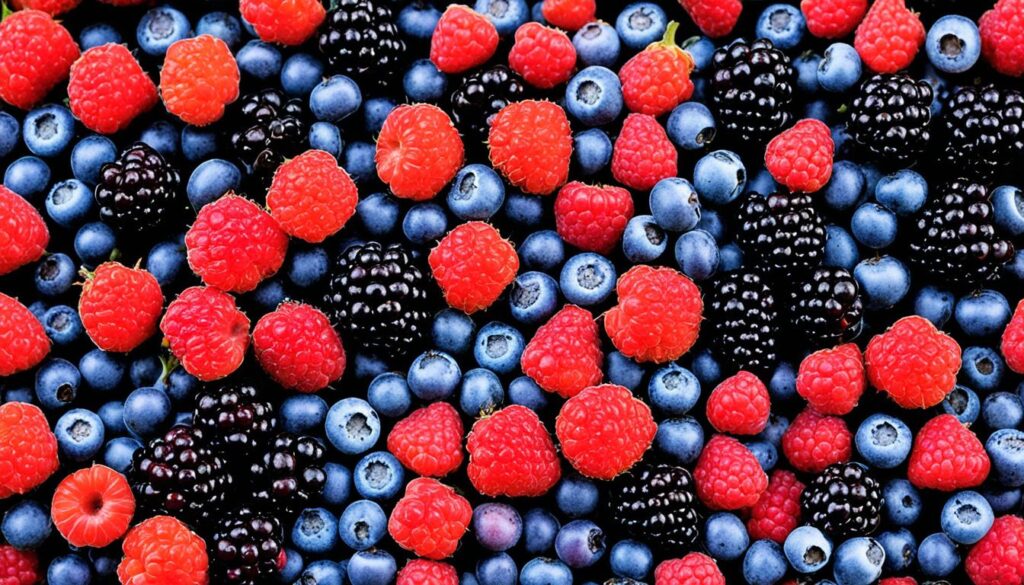
When you explore the outdoors, you might find many edible fruits in the forest. These fruits connect you more with nature. They are a good food source and make foraging exciting.
The types of fruits you find change with your location and the season. Knowing when these fruits are available makes foraging better. It also helps you choose healthy foods.
Introduction to Forest Fruits
Forest fruits are tasty and healthy gifts from nature. They grow in woodlands and offer many flavors and textures. In places like Chicago, Frankfort, and Orland Park, you can find fruits like apples, wild berries, plums, and wild cherries.
These fruits are not just food for humans. They also help keep nature in balance. They feed wildlife and help plants grow. This makes the environment healthy for many animals and plants.
Knowing when and where to find these wild berries is key for picking them. They are full of vitamins and antioxidants. Eating them can make you healthier.

What fruits are found in the forest?
Forests are full of common wild fruits that taste great and are good for you. Foraging for these edible forest fruits lets you connect with nature and enjoy fresh tastes. Here are some popular fruits and when you can find them.
Common Wild Fruits You Can Forage
When you go into the woods at the right time, you might find many foraged fruits. Some you might see are:
- Blackberries
- Elderberries
- Mulberries
- Raspberries
These fruits taste unique and are full of nutrients. They show how much nature gives us, making foraging exciting.
Seasonal Availability of Forest Fruits
Knowing when these fruits are ready is key for foraging. For example:
- Strawberries ripen in late spring.
- Blackberries are ready from late summer to early fall.
- Raspberries peak in mid-summer.
Knowing when to look for each fruit helps you find the tastiest and healthiest ones. Remember, the best time can change by where you are, so check local conditions.

The Diversity of Forest Fruits
Forest fruits come in many types, each with its own taste, texture, and nutrients. When you walk through the forest, you might find many edible fruits that are not well-known but are full of goodness. Learning about these fruits helps you forage better and appreciate nature more.
Understanding Edible Forest Fruits
Edible fruits like serviceberries and huckleberries grow wild and taste different from store-bought ones. They live in special places, making their flavors and nutrients unique. These fruits make our forests richer and feed birds and mammals, helping spread seeds.
Differences Between Cultivated and Wild Fruits
Cultivated fruits are bred to be bigger, sweeter, and look the same. Wild fruits grow on their own, fitting into their surroundings. This makes wild fruits tough and taste special. Here’s how they compare:
| Feature | Cultivated Fruits | Wild Fruits |
|---|---|---|
| Flavor | Usually sweeter and uniform | Diverse flavors, often tart or complex |
| Size | Larger due to selective breeding | Smaller and varied sizes |
| Growth Conditions | Grown in controlled environments | Thrives in natural habitats |
| Nutritional Value | Often fortified or enhanced | Rich in micronutrients and antioxidants |
| Availability | Year-round in stores | Seasonal and dependent on local foraging |

Popular Wild Berries in the Forest
Wild berries are some of the best fruits you can find in the forest. You’ll love the taste of raspberries, blackberries, blueberries, and strawberries. They’re full of vitamins and antioxidants too. Foraging for these fruits is fun and good for your health.
It’s key to know how to spot these berries when you’re out foraging. Here’s a quick guide to some common ones:
- Raspberries: These berries are easy to spot with their bright red or black color. They taste sweet-tart and are great for snacking or desserts.
- Blackberries: These juicy berries grow on thorny bushes. They’re best picked in late summer.
- Blueberries: These small, round berries are a deep blue-purple color. They’re tasty fresh or in jams.
- Strawberries: You’ll find these bright red berries on the ground. They’re sweet and easy to spot.
Knowing when and where to find these berries makes foraging better. Each berry has its own season, so timing is everything. This shows how important it is to know your natural world. Always forage in a way that helps the forest to keep these fruits around for us to enjoy.
Foraged Fruits: What to Look For
Foraging for fruits is a fun way to connect with nature and find tasty plants. It’s key to know which fruits are safe to eat. This knowledge helps you enjoy nature’s gifts safely. Here, we’ll talk about staying safe while foraging and how to do it right.
Identifying Safe Foraged Opportunities
It’s important to know which fruits are safe to pick. Start by learning about the fruits in your area. Look for things like:
- Color: Bright colors usually mean the fruit is ripe and safe to eat.
- Shape: Knowing what safe fruits look like helps you tell them apart from harmful ones.
- Leaf Patterns: The leaves near the fruit can also give clues about the fruit’s safety.
Think about getting a field guide for your area to help with identification. Joining local foraging groups can also teach you more about foraging and the plants around you.
Tips for Foraging Responsibly
Here are some tips to forage responsibly:
- Minimize Impact: Only take what you need to avoid harming the area.
- Respect Wildlife: Keep a safe distance from animals and their homes.
- Follow Local Regulations: Always get permission before foraging in protected places or on private land.
- Avoid Polluted Areas: Keep away from places near roads or industrial sites to stay safe.
By following these tips, you can enjoy foraging and help protect nature. Happy foraging!
Exploring Forest Fruit Trees
Forest fruit trees are key to the ecosystem. They give us many edible fruits that help wildlife and foragers. Trees like apple, pear, and cherry grow well in forests. They give us tasty fruits at certain times of the year.
Knowing when to pick fruits is important. For example, apple seeds picked in late summer and fall grow better. It takes 7 to 10 years for apple trees to grow and produce fruit. If you want faster results, try grafting different apple types onto smaller rootstocks.
Looking after your seedlings is crucial. Start by getting them used to being outside slowly. Make sure they go into a sunny spot with good drainage. Also, put loose soil around the roots to help them grow strong.
Watching out for local wildlife makes foraging more fun. In California, there are now about 65,400 black bears. This is a big jump from the 1980s. Knowing how animals act in the forest is important, especially near homes.
| Tree Type | Season of Harvest | Time to Maturity | Grafting Benefits |
|---|---|---|---|
| Apple | Late summer to fall | 7 to 10 years | Accelerates fruiting |
| Pear | Summer | 3 to 7 years | Improves resilience |
| Cherry | Late spring to early summer | 4 to 6 years | Enhances flavor |
Learning about forest fruit trees makes foraging better. It also connects you more with nature. By knowing how to pick these fruits the right way, you can enjoy what nature offers.
Wild Fruit Varieties to Discover
Exploring wild fruit varieties makes foraging exciting. You can find elderberries and blackberries, each with unique tastes and health benefits. Let’s dive into these wild treasures and see how they can be used in cooking.
Elderberries: The Underrated Gem
Elderberries are a hidden gem in the wild. They are small, dark berries full of nutrients. They have lots of vitamins C and antioxidants, which are good for your health.
You can make syrups, jellies, and wine from them. They are versatile in the kitchen. Look for small, dark purple to black berries on elderflower shrubs when foraging. But remember, cook them first because raw elderberries can be toxic.
Blackberries and Their Common Varieties
Blackberries are a favorite among foragers for their sweet taste and health perks. They are full of fiber, vitamins, and minerals. This makes them a great snack.
There are many types, like Marionberries and Boysenberries, each with a unique flavor. You’ll find them in brambles or thorny bushes in summer. Always pick ripe berries for the best taste and quality.
| Wild Fruit | Key Nutrients | Common Uses |
|---|---|---|
| Elderberries | Vitamin C, Antioxidants | Syrups, Jams, Wine |
| Blackberries | Fiber, Vitamins, Minerals | Smoothies, Desserts, Jams |
Forest Fruit Picking: A Seasonal Activity
Forest fruit picking is a great way to enjoy nature and get fresh fruits. Different fruits grow in the forest all year, each with its own seasonal availability. Knowing when to pick them makes the experience better and helps you get more fruit.
When is best to forage varies by fruit. Spring brings strawberries and early wild blueberries. Summer has blackberries and raspberries. As summer ends, apples are ready to pick, making forest fruit picking a great time.
Foraging connects you with nature, encouraging you to explore and appreciate the world around you. It becomes a special activity that brings people together. Sharing stories and recipes about the fruits you find strengthens bonds and teaches about nature and sustainable living.
| Fruit Type | Best Foraging Season | Notes |
|---|---|---|
| Wild Strawberries | Spring | Small but intensely sweet; ideal for jams. |
| Blackberries | Summer | Great fresh or in desserts. |
| Apples | Fall | Harvest from freshly fallen fruits for better tasting. |
Forest fruit picking is good for your health. Wild berries are full of nutrients, more so than store-bought ones. If you’re into healthy eating, you might find interesting facts at this link.
This activity does more than feed your body. It also lifts your spirit, letting you enjoy nature’s gifts. It teaches the value of sustainable foraging.
Benefits of Eating Edible Forest Fruits
Eating forest fruits is good for you. They are full of nutrients that help your health. These fruits are great for a healthy lifestyle.
Nutritional Value of Wild Berries
Wild berries are full of good stuff. They have vitamins, minerals, and fiber. This makes them a great choice for your meals.
- High in Vitamin C, which boosts the immune system.
- Rich in antioxidants, helping to combat oxidative stress.
- Good source of dietary fiber, promoting healthy digestion.
These fruits are packed with benefits. They make you healthier overall.
Health Benefits of Foraged Fruits
Eating foraged fruits is good for your health. Studies show it can help prevent depression. The fruits are full of antioxidants.
These antioxidants fight inflammation and stress. This is good for your mind and body. Eating fruits daily can lower the risk of depression by 21%. This shows how important it is to eat these fruits.
Wild berries and other foraged fruits are tasty and healthy. They are like nature’s health boosters.
Using Forest Fruits in Cooking
Turning forest fruits into tasty dishes opens up new culinary adventures. Using foraged berries adds amazing flavors and brings nature into your kitchen. We’ll look at creative recipes that show off these great ingredients. Also, we’ll talk about how to preserve fruits through canning and freezing, so you can enjoy them later.
Recipes Featuring Foraged Berries
Cooking with foraged berries makes delicious dishes. Here are some tasty ideas:
- Wild Berry Pie: Combine blueberries, blackberries, and raspberries for a classic dessert with a flaky crust.
- Berry Jam: Mix foraged berries with sugar and lemon juice for homemade jam. It’s great on toast or in baking.
- Berry Sauce: Cook berries with honey and spices. It’s perfect for topping pancakes or desserts.
Preserving the Harvest: Canning and Freezing Tips
Preserving fruits is key to enjoying forest fruits all year. Here are some important tips:
- Canning: Sterilize jars and lids, fill with boiling fruit mixtures, and seal tightly. This keeps your homemade jams and sauces fresh.
- Freezing: Wash and dry berries, then spread them on a baking sheet to freeze. Once frozen, put them in airtight containers.
- Labeling: Always label containers with the fruit type and preservation date. It makes finding them later easy.
Conclusion: Embrace the Forest’s Bounty
Exploring the forest can be amazing when you know about edible fruits. Learning to forage for these fruits helps you and the environment. It shows how important it is to use the forest’s gifts.
Foraging lets you connect with nature and support sustainability. Wild fruits are full of nutrients, good for you and the planet. Each fruit has a story of survival and connection to the earth.
Using these fruits in cooking can be fun and creative. To learn more, think about joining workshops or retreats about nature’s gifts. For a special experience, check out programs led by experts.



